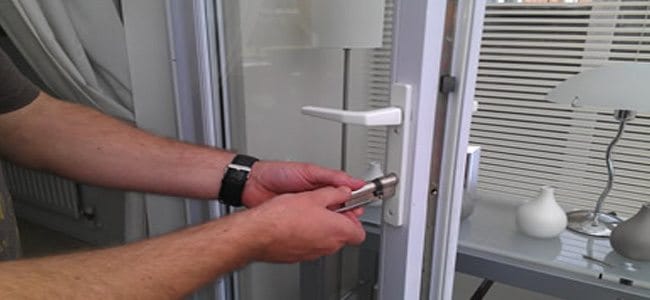UPVC door locks have become increasingly popular among homeowners and commercial property owners in the UK for their durability, security and low maintenance.
This article aims to provide you with comprehensive advice from expert locksmiths on UPVC door locks, helping you to better understand the different types, their mechanisms, and how to choose the best lock for your needs.
We will also discuss maintenance tips, common issues, and when to call a locksmith for assistance.
What is UPVC and why is it popular?
Unplasticised Polyvinyl Chloride (UPVC) is a type of plastic that has gained popularity in the construction industry, particularly for doors and windows. UPVC is known for its durability, low maintenance, and insulation properties.
Advantages of UPVC doors
Some of the key benefits of UPVC doors include:
- Energy efficiency: UPVC doors provide excellent insulation, helping to reduce energy consumption and lower heating bills.
- Low maintenance: These doors require minimal upkeep and are resistant to rot, corrosion, and discolouration.
- Affordability: Compared to other materials like timber or aluminium, UPVC doors are more cost-effective.
- Customisation: UPVC doors are available in various styles, colours, and finishes, allowing you to find the perfect match for your property.
Different types of UPVC doors
There are several types of UPVC doors available, including:
- Front doors: These are the main entrance doors, designed to offer security and insulation.
- Back doors: Typically used for rear entrances, these doors often have large glass panels to allow natural light into the home.
- Patio doors: These sliding or hinged doors connect the indoors to outdoor living spaces such as gardens or patios.
- French doors: Featuring two adjacent doors that open outwards, French doors are ideal for creating an elegant and spacious entrance.
- Bi-fold doors: Comprising multiple panels that fold together, bi-fold doors are an excellent option for large openings.
Understanding UPVC door lock mechanisms
There are several lock mechanisms used in UPVC doors, and understanding how they work is essential for making an informed decision when choosing the right lock for your needs.
Multi-point locking systems
Multi-point locking systems are the most common type of lock mechanism used in UPVC doors. These locks have multiple locking points, typically three or five, which secure the door at various points along its length.
When the key is turned, all locking points are engaged simultaneously, providing enhanced security. Multi-point locking systems can include a combination of hooks, bolts, and rollers, depending on the specific design.
Euro cylinder locks
Euro cylinder locks are a popular choice for UPVC doors due to their versatility and ease of installation.
These locks consist of a cylinder that can be replaced independently of the rest of the lock mechanism, making them a cost-effective option for upgrading or replacing an existing lock.
Euro cylinder locks come in various security levels, including standard, anti-snap, and high-security options.
UPVC door handle lock
Some UPVC doors come with a built-in handle lock, which adds an additional layer of security. The handle lock operates independently from the main locking system and usually requires a separate key to unlock.
This type of lock can be particularly useful in preventing unauthorised access through the use of a credit card or other bypass methods.
Tips for choosing the right UPVC door lock
When selecting a UPVC door lock, it’s essential to consider the following factors:
Consider security ratings
Lock security ratings, such as the British Standard Kitemark (BSI) or the Sold Secure rating, can provide an indication of a lock’s resistance to forced entry. Look for locks that have been tested and certified to ensure that they meet the necessary security standards.
Look for anti-snap features
Cylinder snapping is a common technique used by burglars to gain entry to properties with UPVC doors. To counter this threat, choose a lock with anti-snap features, such as a sacrificial cut line or reinforced cylinder.
Keep door thickness in mind
The thickness of your UPVC door will impact the type of lock that can be installed. Ensure you measure the door thickness accurately and select a lock that is compatible with your specific door.
How to maintain your UPVC door locks
Proper maintenance of your UPVC door locks can help prolong their lifespan and ensure optimal performance. Here are some tips for maintaining your locks:
Cleaning and lubrication
Clean the lock cylinder regularly using a damp cloth and mild detergent to remove dirt and debris. Apply a suitable lock lubricant, such as graphite or silicone-based lubricant, to the keyway and moving parts to prevent sticking and wear.
Inspect for wear and tear
Regularly check the lock for signs of wear, including loose screws, misaligned parts, or damaged components. Address any issues promptly to prevent further damage or security risks.
Adjusting the lock
Over time, the door and frame may shift slightly, causing the lock to become misaligned. If you notice that the lock is difficult to operate or doesn’t engage fully, you may need to adjust the lock or door hinges to restore proper alignment.
Common issues with UPVC door locks and how to fix them
Despite their durability, UPVC door locks can still encounter problems. Here are some common issues and how to fix them:
Stuck or jammed lock
A stuck or jammed lock can often be resolved by lubricating the lock mechanism. If this doesn’t resolve the issue, the lock may be damaged or misaligned, requiring professional attention.
Key won’t turn
If the key won’t turn in the lock, it could be due to a worn or damaged key, a misaligned lock, or a seized lock mechanism. Try using a spare key, lubricating the lock, or adjusting the door alignment to resolve the issue.
Door alignment issues
If the door is difficult to close or lock, it may be due to misalignment between the door and the frame. This can be caused by the door or frame warping, or the hinges loosening over time.
Adjusting the door hinges or repositioning the lock strike plate may resolve the problem. If not, you may need to consult a professional locksmith or door specialist.
When to call a locksmith
While some minor issues with UPVC door locks can be resolved through DIY solutions, it’s essential to know when to call a professional locksmith. Some situations that warrant the help of an expert include:
- Persistent locking issues despite DIY attempts to fix the problem
- Damaged or broken lock components
- Security concerns, such as a compromised lock or cylinder snapping
- The need for lock upgrades or replacements
A professional local locksmith can diagnose and resolve UPVC door lock issues efficiently and safely, ensuring the continued security of your property.
Conclusion
UPVC door locks offer numerous benefits for homeowners and commercial property owners, including durability, low maintenance, and enhanced security.
By understanding the different types of UPVC door locks, their mechanisms, and how to choose the right lock for your needs, you can make informed decisions that protect your property.
Regular maintenance, addressing common issues, and knowing when to call a locksmith are essential aspects of ensuring the longevity and performance of your UPVC door locks.
By following the expert advice provided in this article, you can enjoy the peace of mind that comes with a secure and well-maintained UPVC door lock system.

